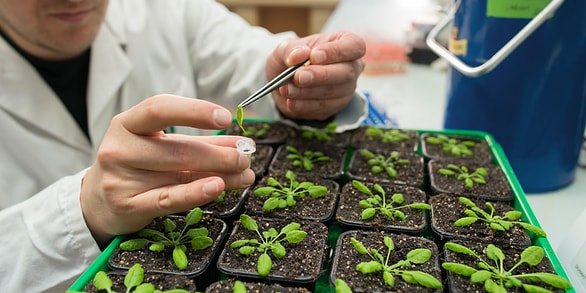Back to: AGRICULTURAL SCIENCE SS2
Welcome to Class !!
We are eager to have you join us !!
In today’s Agricultural Science class, We will be learning about Crop Improvement. We hope you enjoy the class!

MENDELIAN LAWS
- The first law of Mendel is also called the law of segregation of genes states that; genes are responsible for the development of the individual and that they are independently transmitted from one generation to another without undergoing any alteration. This is clearly seen in monohybrid crossing.
- The second law of Mendel which is also called the law of independent assortment of genes states that each character behaves as a separate unit and is inherited independently of any other character. This is clearly seen in the dihybrid crossing.

PROCESS OF CROP IMPROVEMENT
These include; introduction, selection and breeding of hybridization.
A) INTRODUCTION: This involves the importation or introduction of some varieties of crops with desirable characteristics into areas where they have not existed before.
ADVANTAGES
- It helps in bringing a new variety to new areas
- It may enhance greater productivity
- It may perform better if there is a better climate condition
- The past of the crop of the crops is usually absent in the new area
DISADVANTAGES
- There is the possibility of introducing new diseases
- The crop may not be able to adapt to the climatic condition of the new environment
- It may introduce new pests to the new environment
- It may not be able to adapt to the soil condition of the area
B) SELECTION: This involves the picking of crops with desirable characteristics which are most favoured by the environment. Selection could be natural or artificial.
Natural selection involves the ability of a crop to survive a wide range of environmental conditions and still remain standing.
Artificial selection involves the use of man’s intelligence to retain crops with desired traits on the farm.
Methods of artificial selection include;
- Mass Selection: Crops with desirable characteristics are selected among others.
- Pure line Selection: Only one crop plant with good characteristics is selected
- Pedigree Selection: Crop plants are selected based on the performance of their ancestors
- Progeny Selection: Crop plants are selected based on the performance of their offsprings
ADVANTAGES OF SELECTION
- It ensures that only the best naturally available crop is grown
- Crops with desired qualities are selected
- Seeds from the best stands are multiplied for distribution
- It reduces the spread of diseases and pests
DISADVANTAGES OF SELECTION
- Selection is tedious and time-consuming
- It is very expensive in term of time and money
- It requires expertise
- It causes elimination of some desirable traits of the parent stock
C) BREEDING OR HYBRIDIZATION: is a method by which an offspring is produced through the crossing of two different plant varieties of the same spices
TYPES OF BREEDING
- Inbreeding: This is the pollination and fertilization of closely related crop plants. This can lead to pure breed or pure line
- Pure line: It is obtained when a plant is being self-fertilized or crossed continuously with a closely related species for many generations so that the desirable qualities it possesses does not change from one generation to another.
- Cross Breeding: This is the pollination and fertilization of unrelated crop plants belonging to different breeds. This results in the production of hybrids
ADVANTAGES OF BREEDING
- It can produce a superior offspring resulting in hybrid vigour or heterosis
- Progeny grow more rapidly in crossbreeding
- Offsprings can withstand the variation of environment
DISADVANTAGES OF BREEDING
- Inbreeding leads to depressing or loss in vigour and performance of offspring.
- There is a drop in production of the crops in quantity and quality in inbreeding
- It may lead to poor or low resistance to disease attacks in inbreeding
METHODS OF IMPROVING CROP PRODUCTIVITY
- By crop improvement (Introduction, selection and breeding)
- Planting at the proper time
- Adoption of better cultivation methods
- Use of manures and fertilizers
- Control of pests of crops
- Control of diseases of crops
- Use of Resistant varieties
- Use of good crop varieties
GENERAL EVALUATION
- State the Mendelian laws
- What is crop improvement
- List three aims of crop improvement
- State two advantages of breeding
- State two methods of improving crop productivity
READING ASSIGNMENT
- Essential Agricultural Science for Senior Secondary School by O.A. Iwena Chapter 39 pages 366-376
- Answer the following questions from WAEC PAQ 2005 theory question 6, 2008 theory question 6, 2009 theory question 5 and 2011 theory question 6
THEORY
- What is crop improvement?
- State two aims of crop improvement
- State the Mendelian laws
- State two methods of improving crop productivity
We have come to the end of this class. We do hope you enjoyed the class?
Should you have any further question, feel free to ask in the comment section below and trust us to respond as soon as possible.
In our next class, we will be learning about Basic Economic Principles in Agriculture. We are very much eager to meet you there.

Please can u explain the mendelian law
these are definition of some genetic terms in other to understand the Mendelian laws and usefulness in plant breeding.
it is important to know some technical words which you shall come across in crop improvement
1. Genes
2.chromosomes
3characters or traits
The teachings are self explanatory and easily comprehensible.Thos can be used as a teaching material, keep it up 👍.
Nice 👍 & well explained.